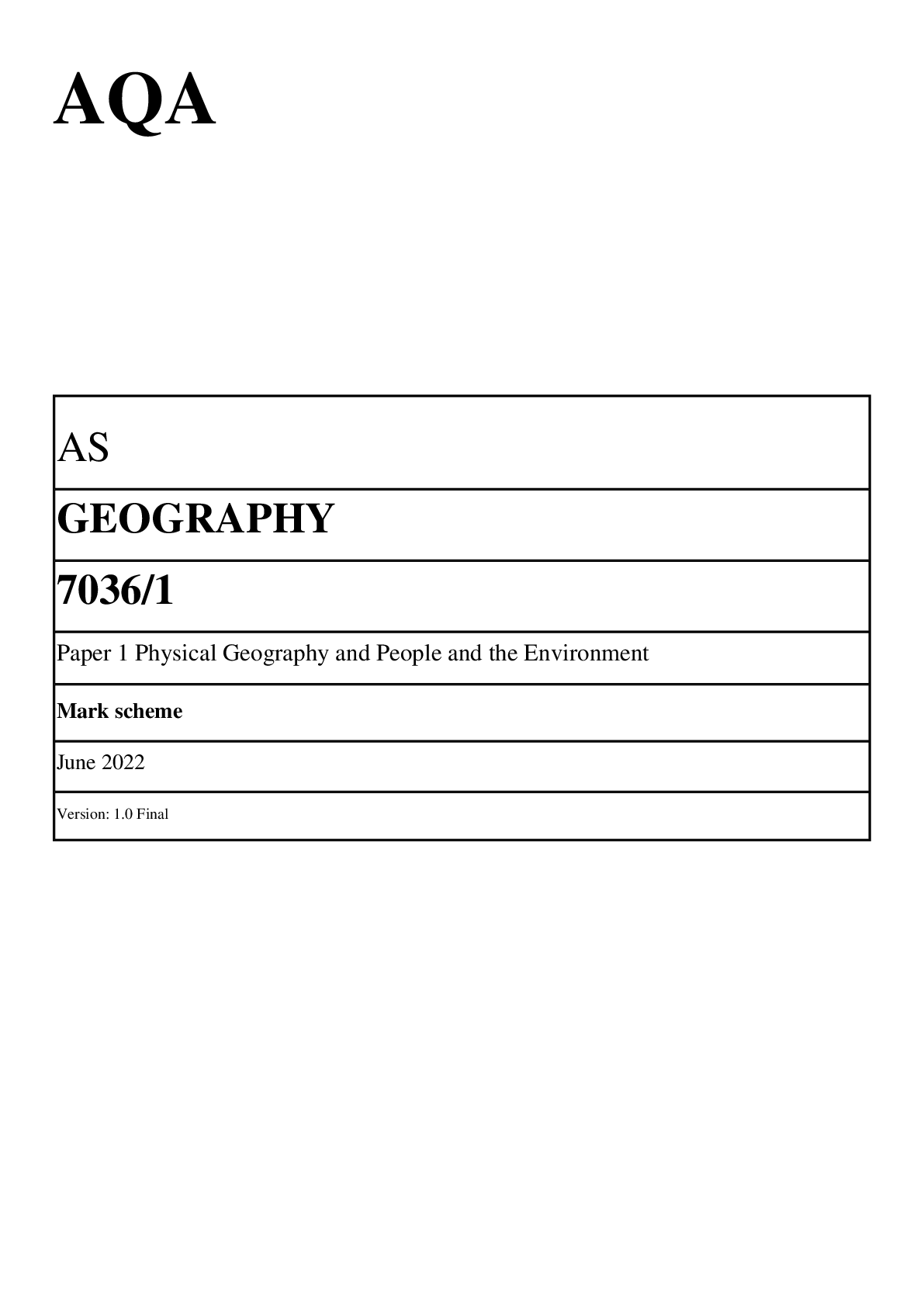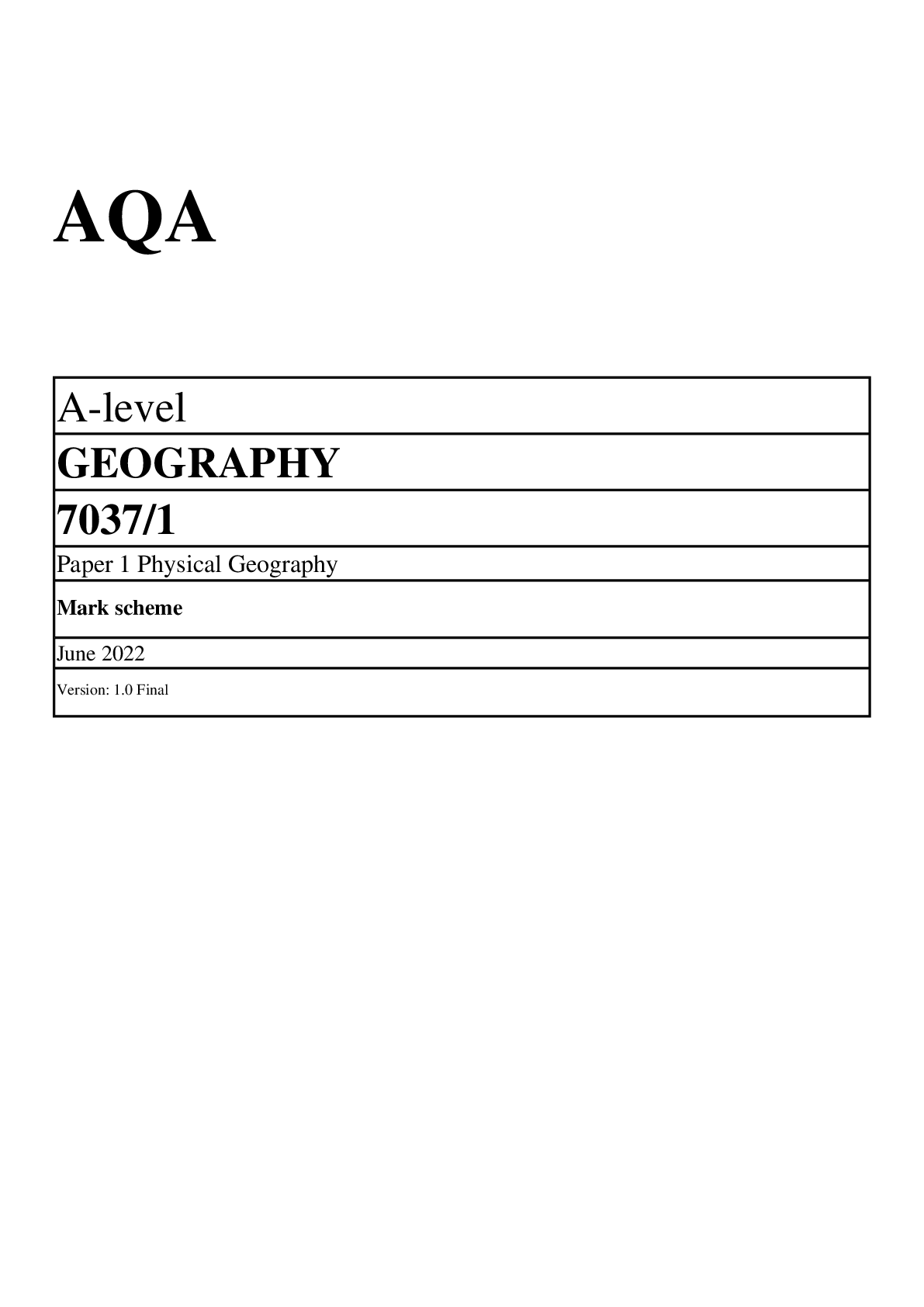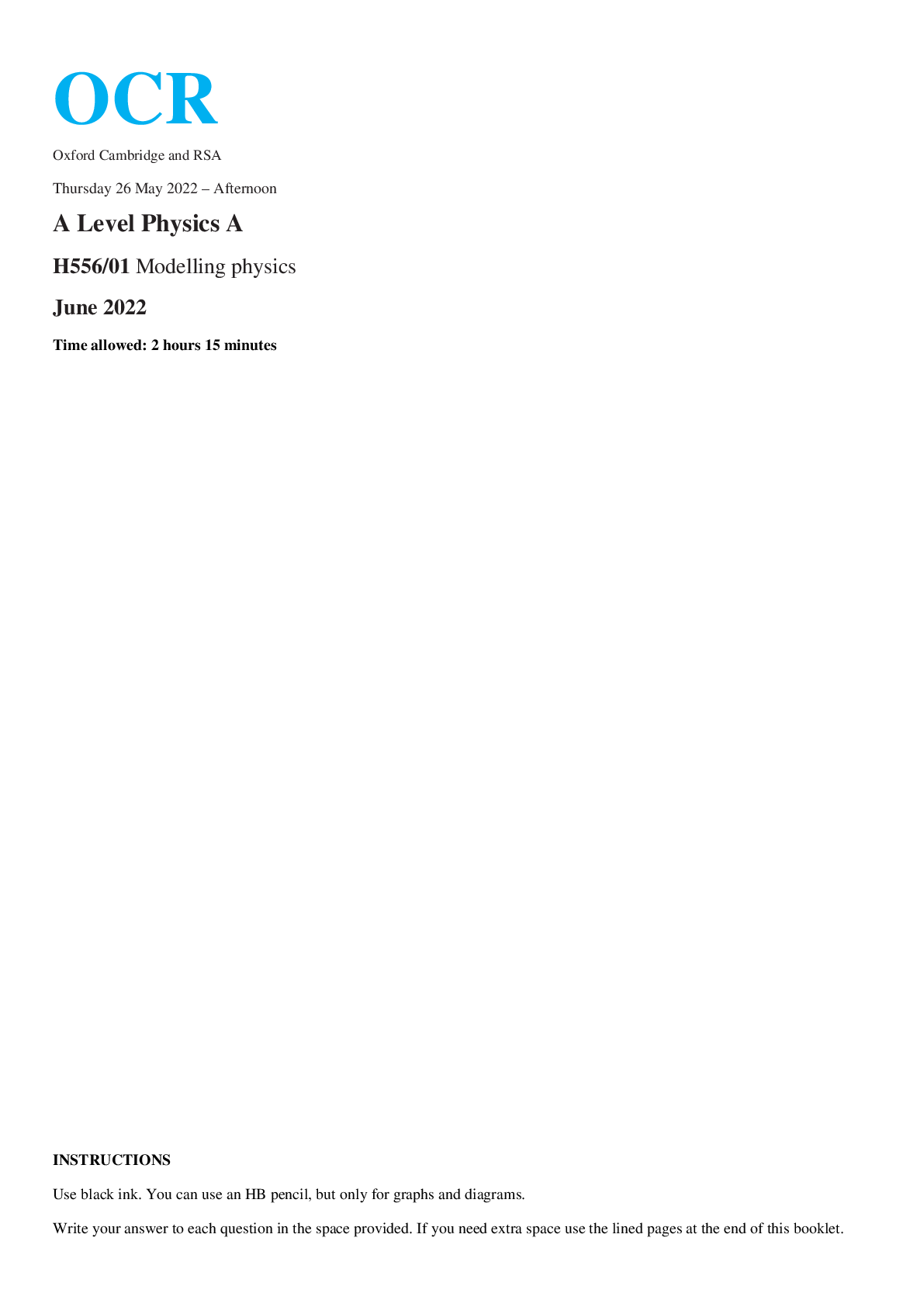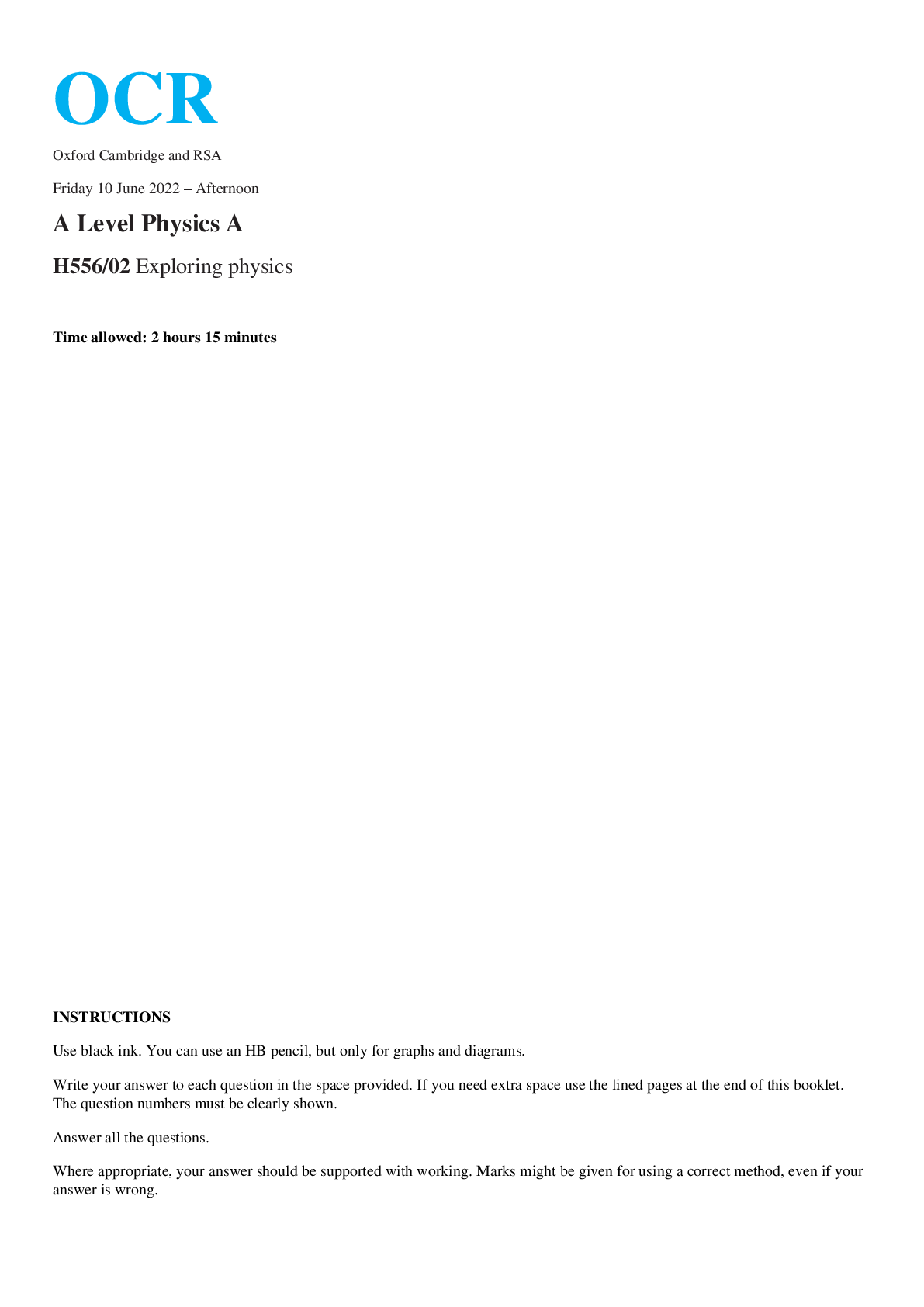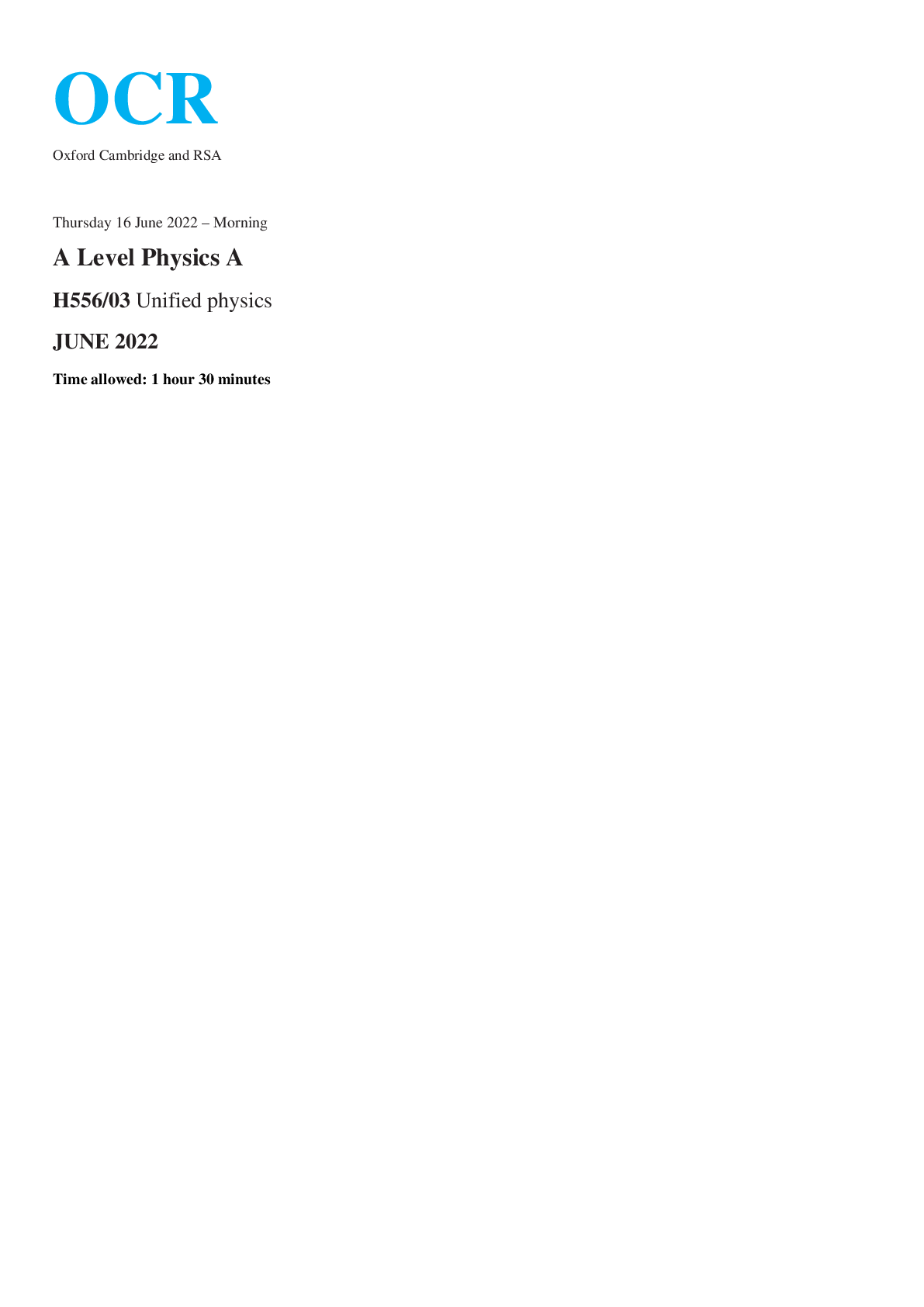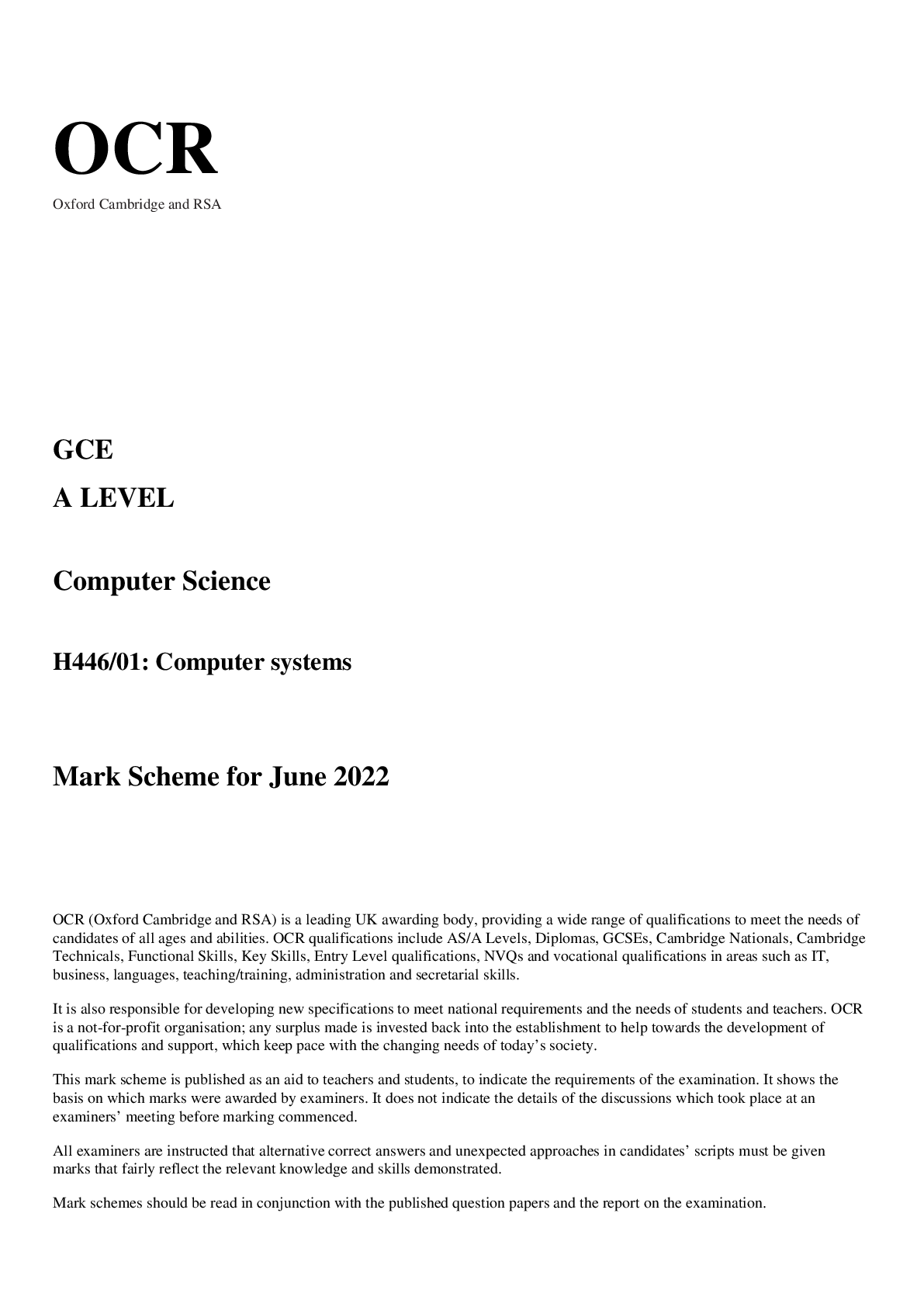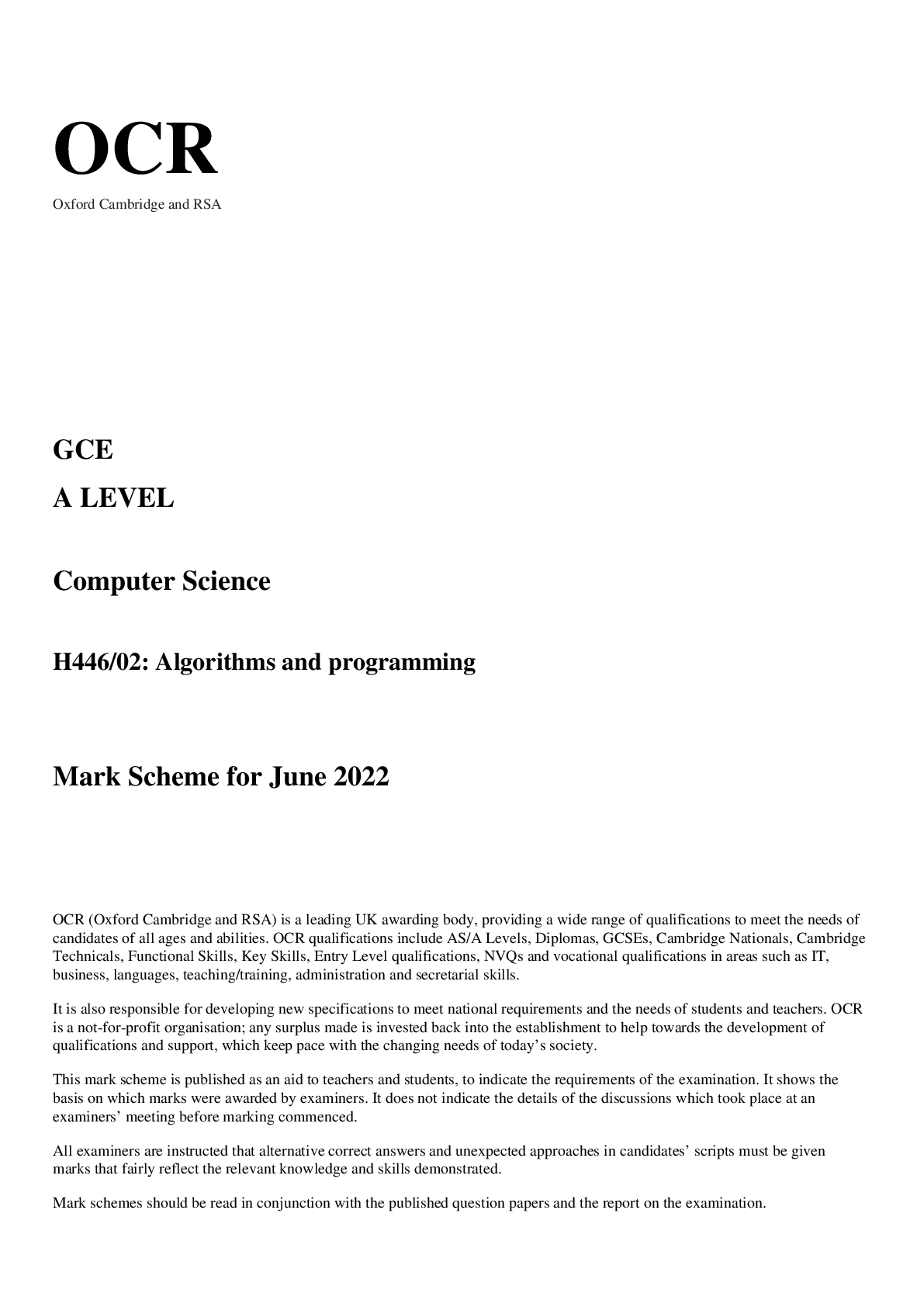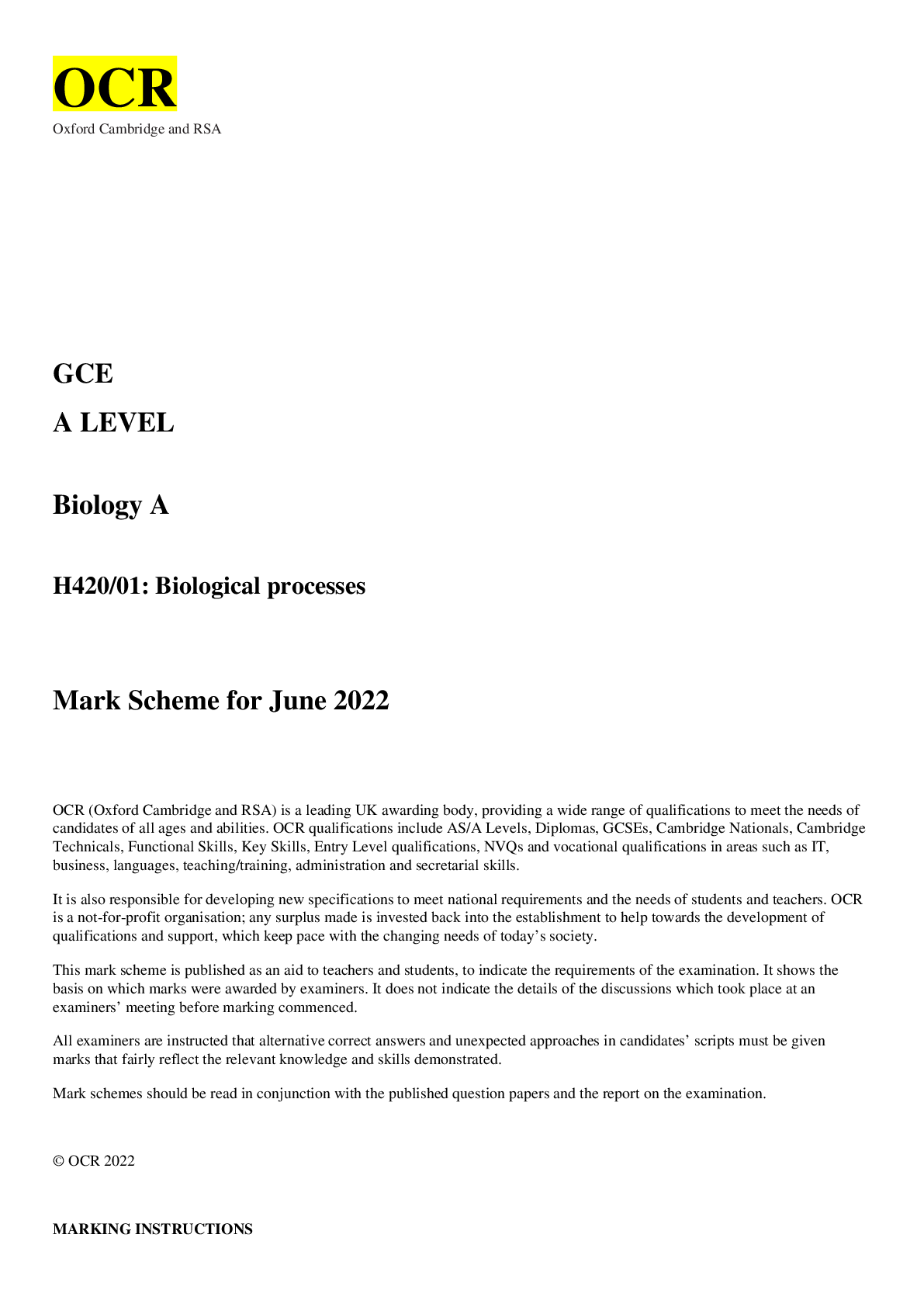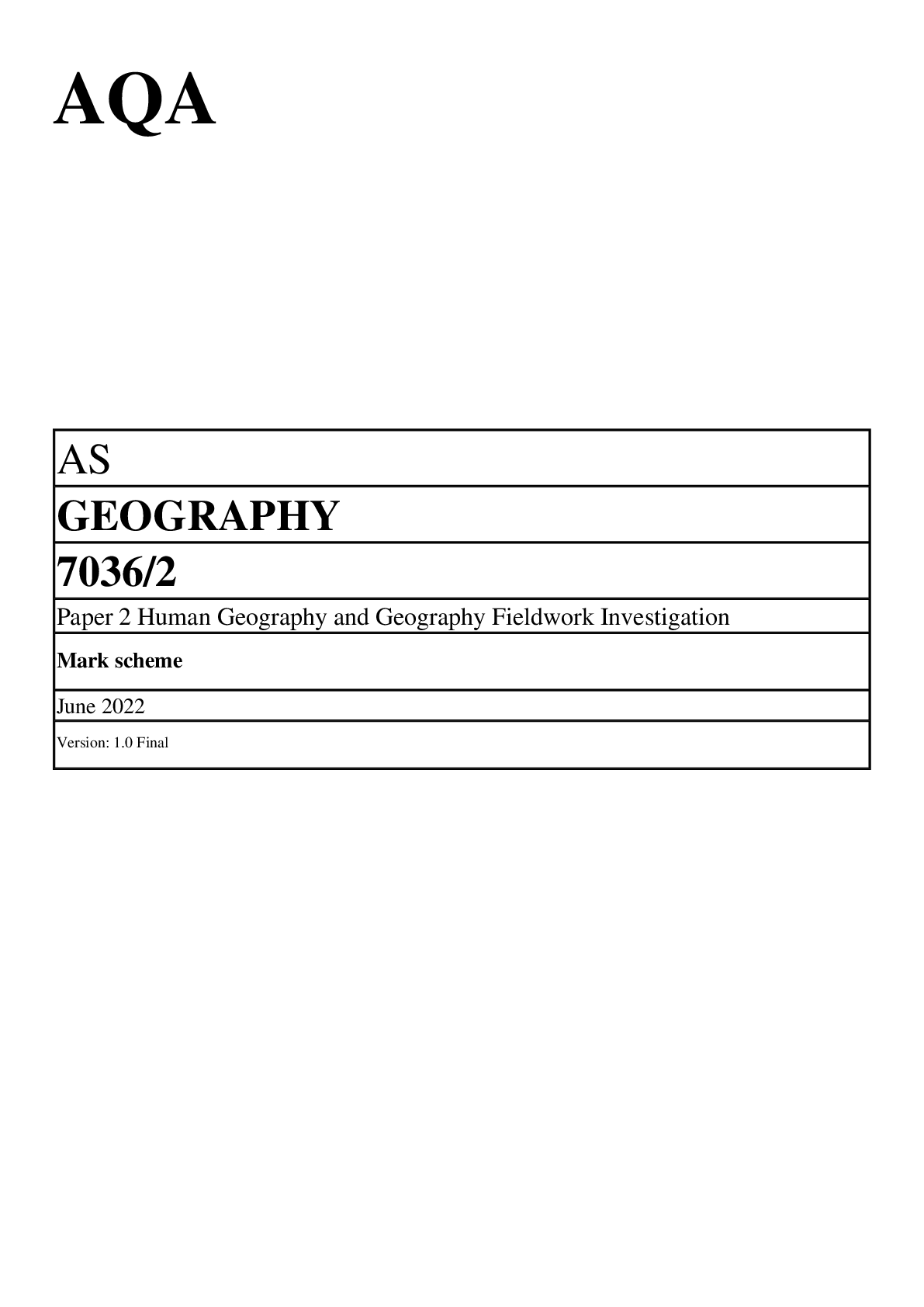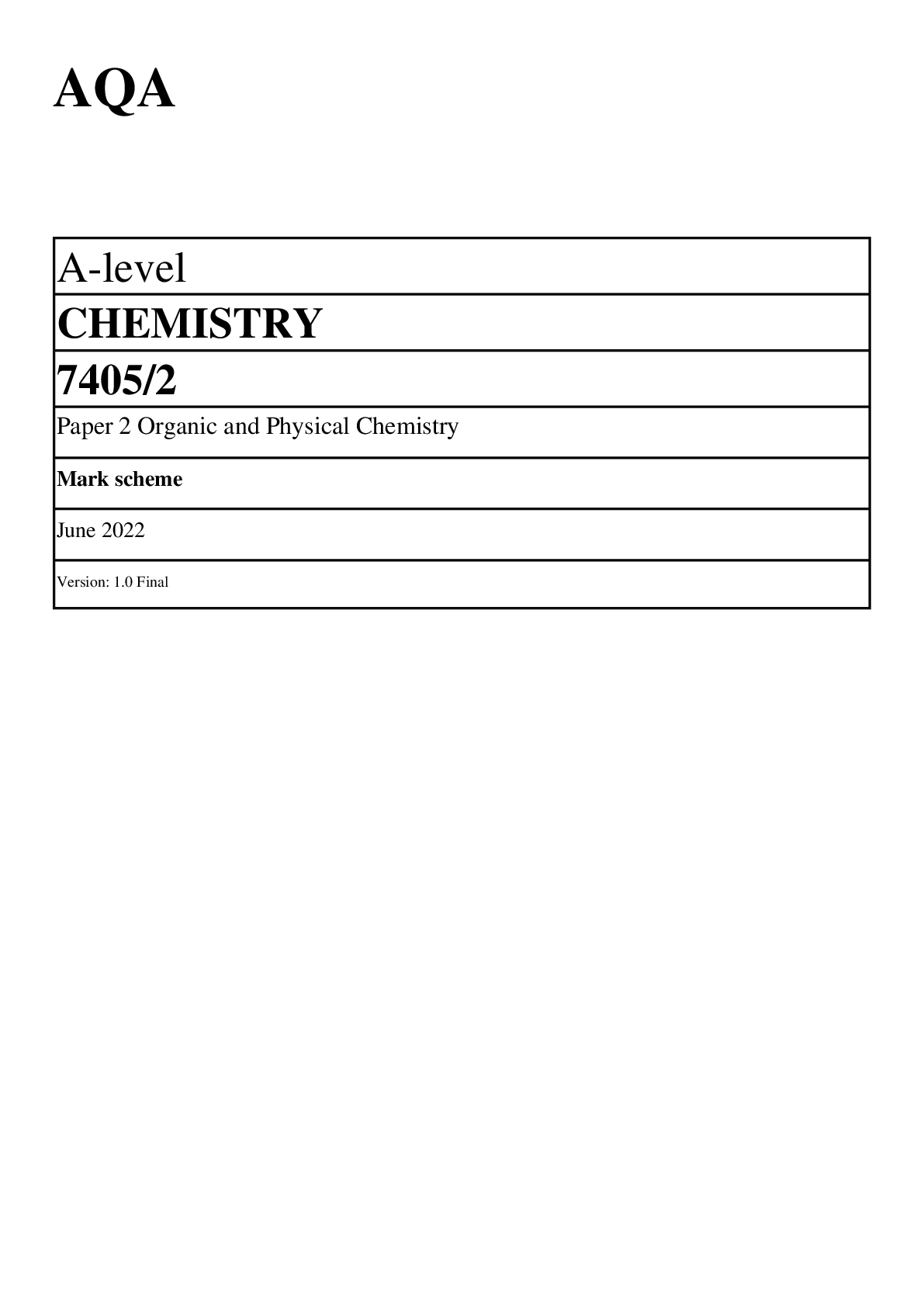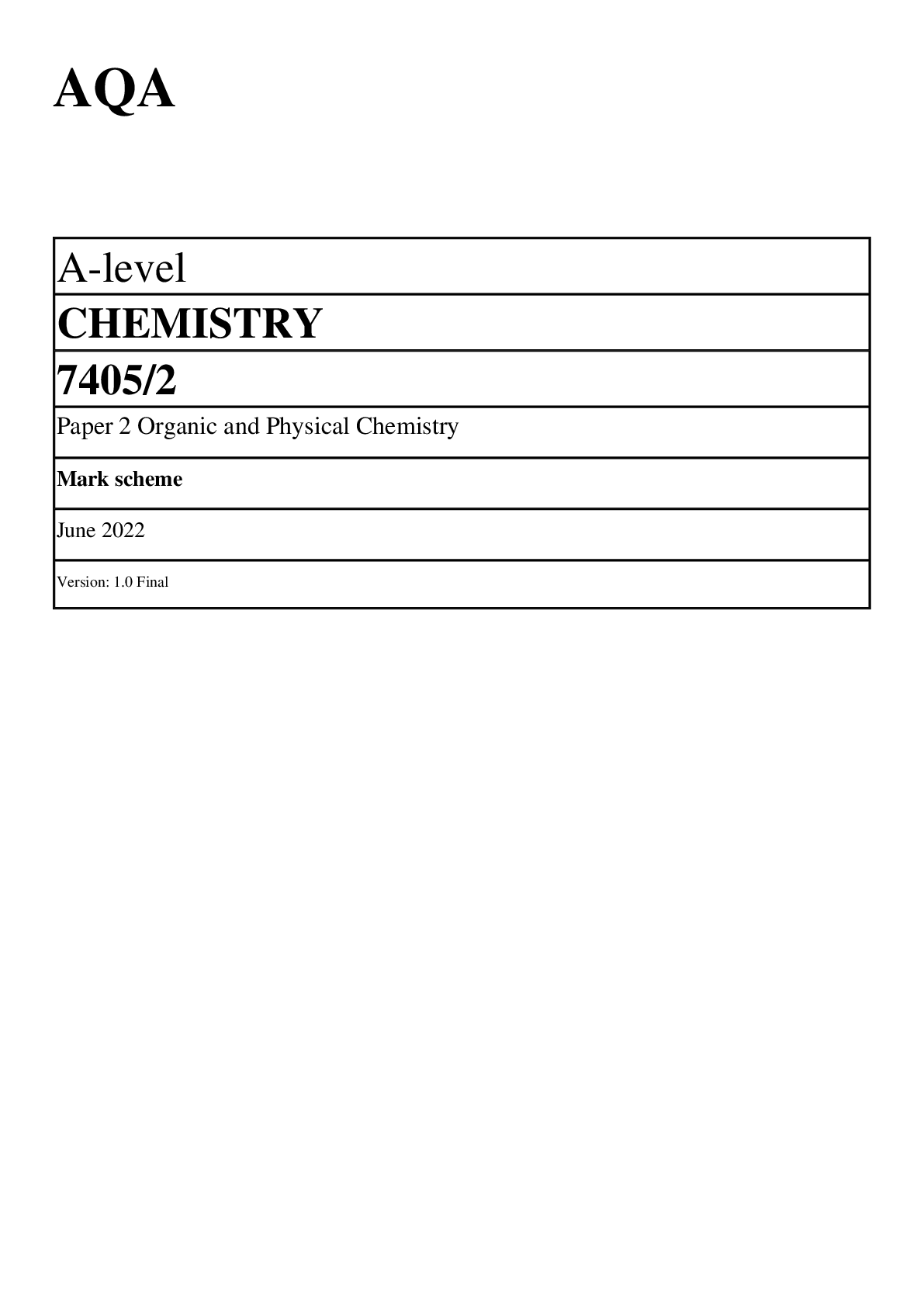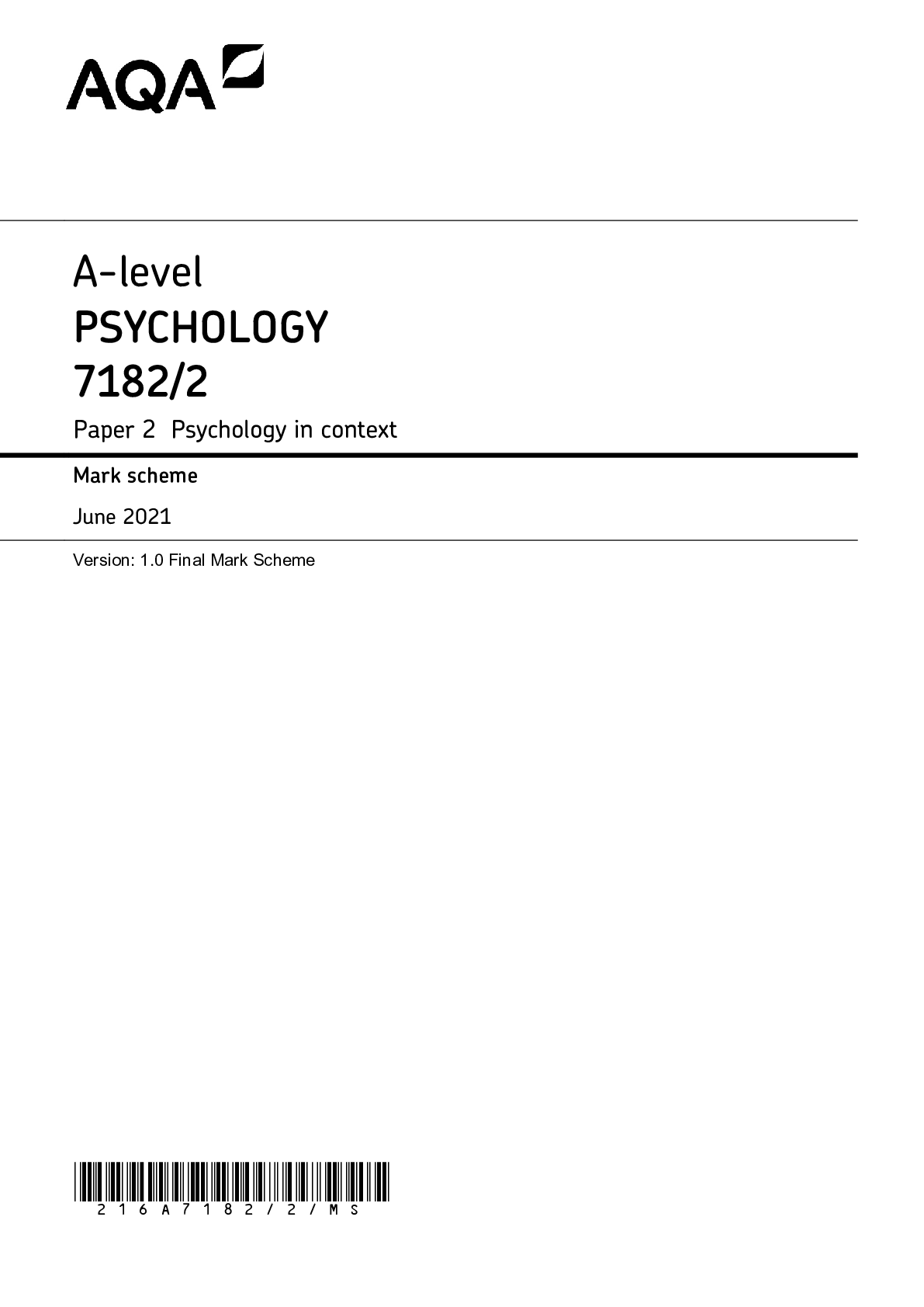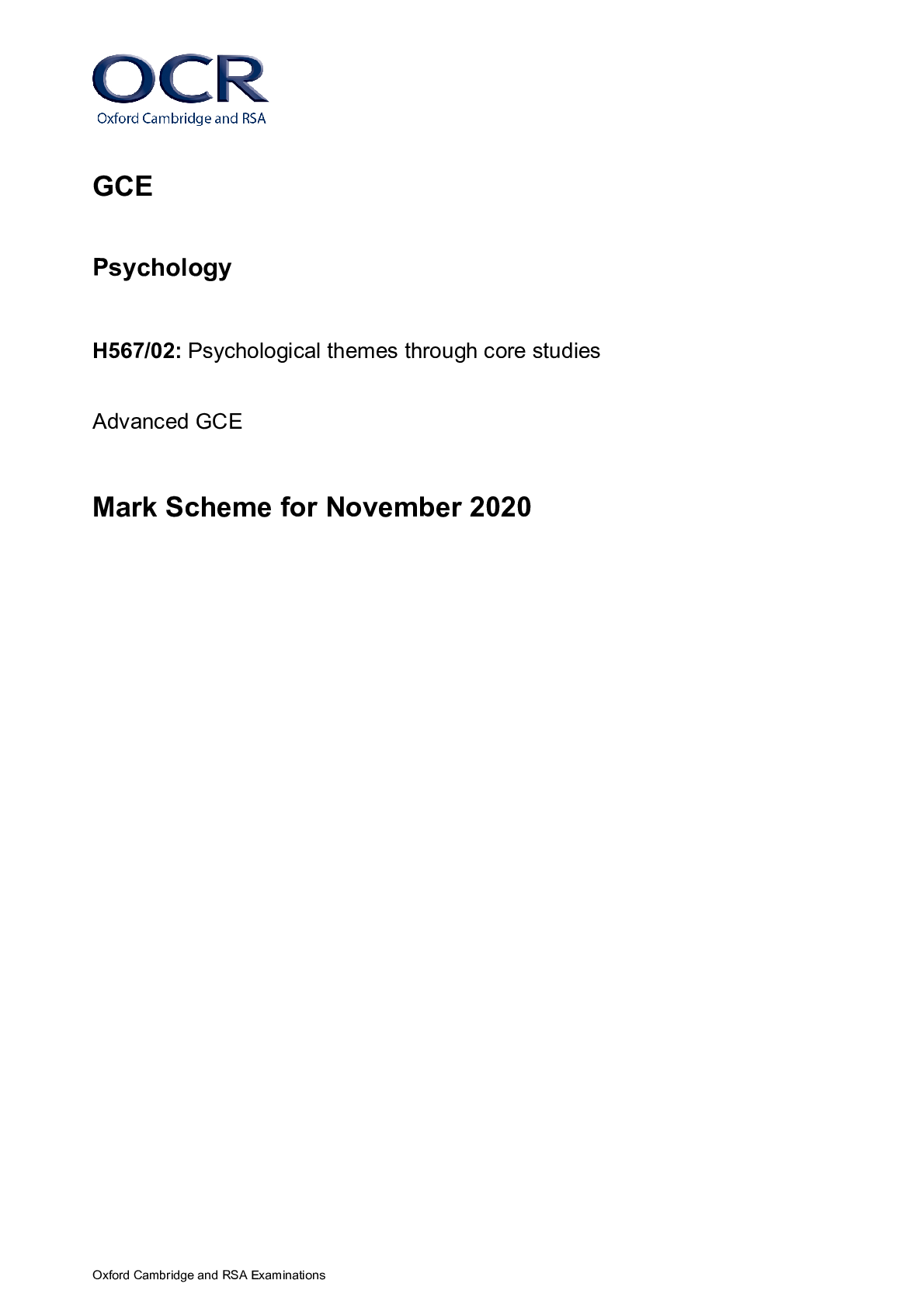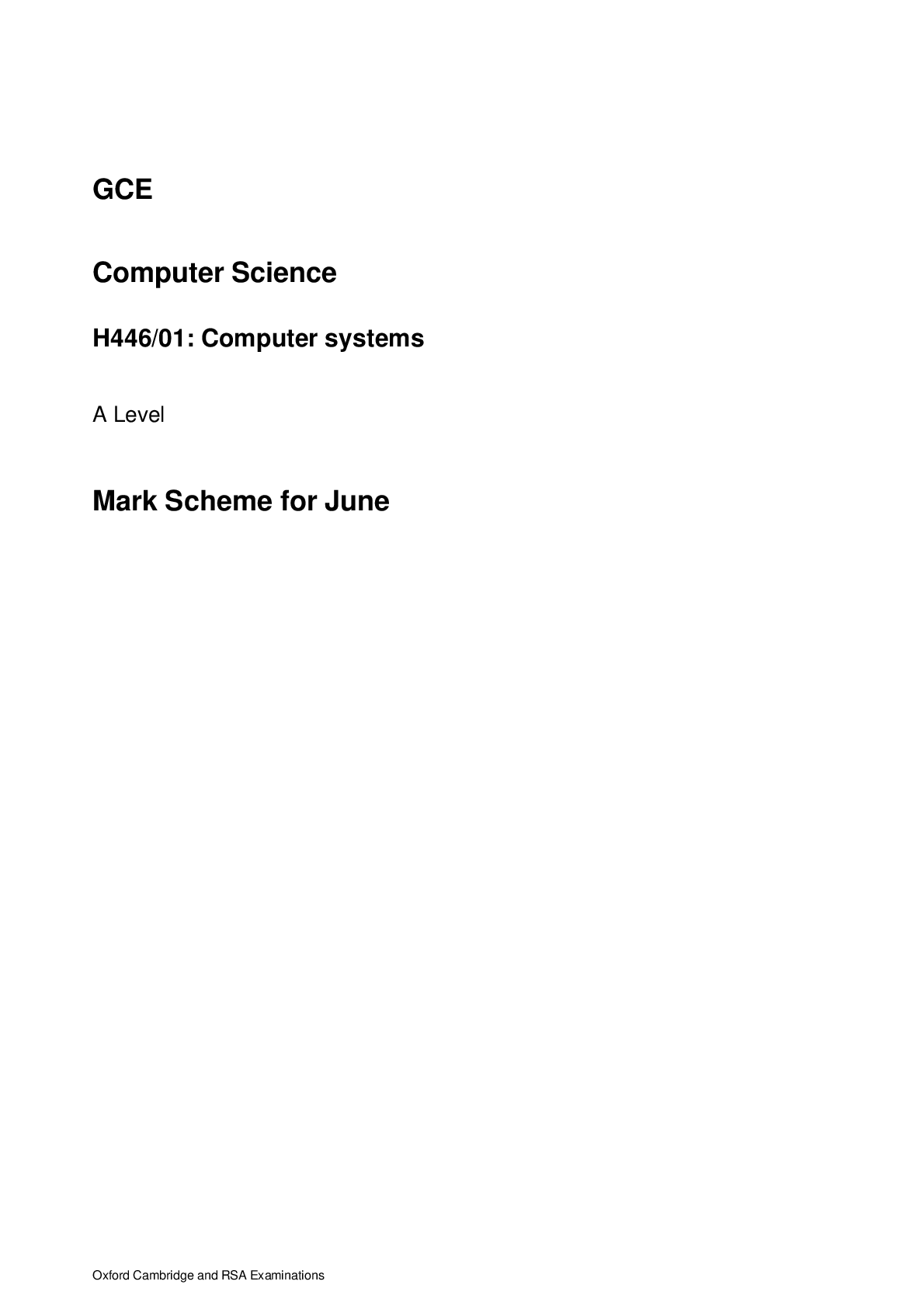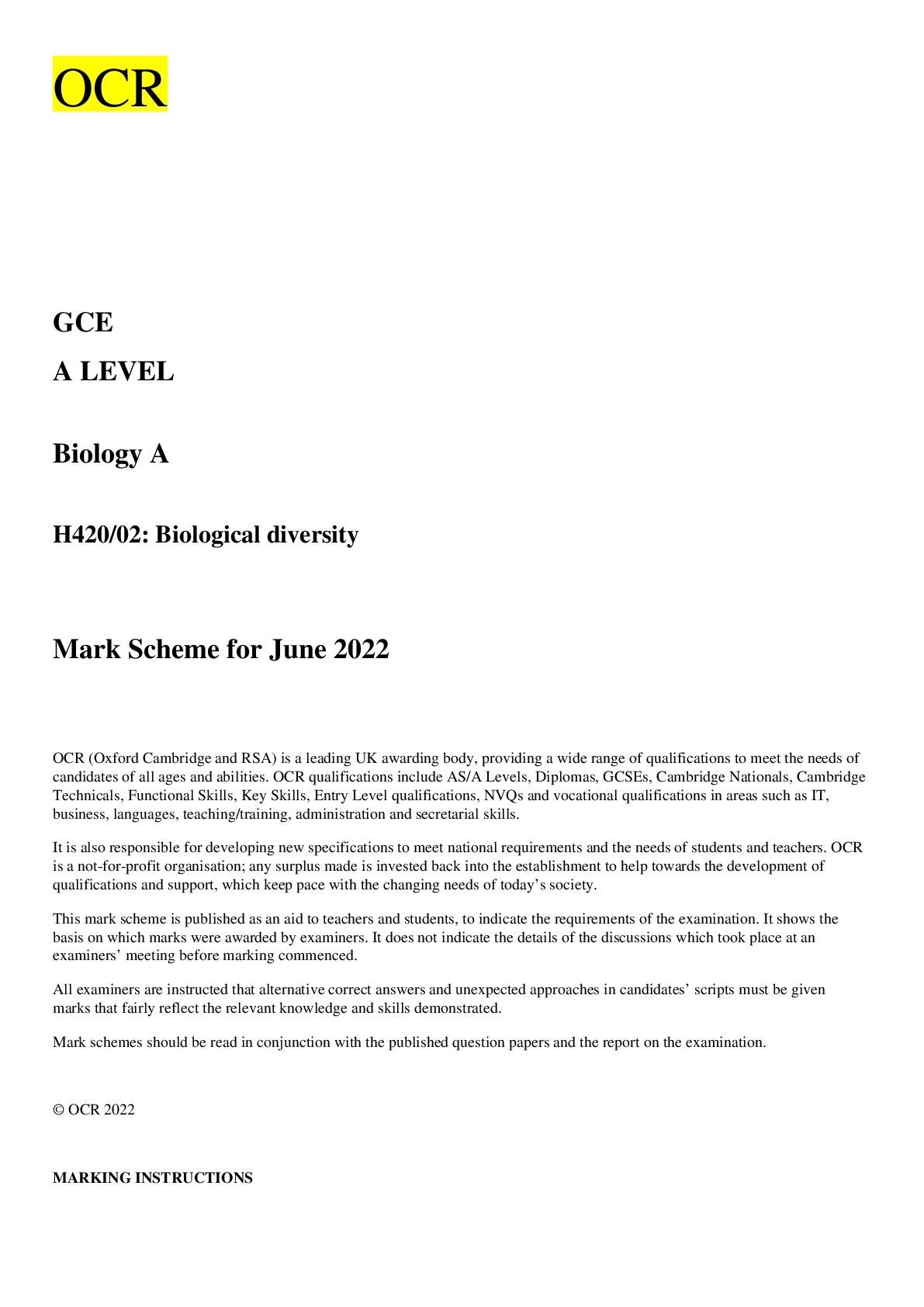OCR > A-Level Mark Scheme > OCR AS Level Psychology H167/02: Psychological themes through core studies Mark Scheme for June 2 (All)
OCR AS Level Psychology H167/02: Psychological themes through core studies Mark Scheme for June 2022
Document Content and Description Below
AS Level Psychology H167/02: Psychological themes through core studies Mark Scheme for June 2022 OCR (Oxford Cambridge and RSA) is a leading UK awarding body, providing a wide range... of qualifications to meet the needs of candidates of all ages and abilities. OCR qualifications include AS/A Levels, Diplomas, GCSEs, Cambridge Nationals, Cambridge Technicals, Functional Skills, Key Skills, Entry Level qualifications, NVQs and vocational qualifications in areas such as IT, business, languages, teaching/training, administration and secretarial skills. It is also responsible for developing new specifications to meet national requirements and the needs of students and teachers. OCR is a not-for-profit organisation; any surplus made is invested back into the establishment to help towards the development of qualifications and support, which keep pace with the changing needs of today’s society. This mark scheme is published as an aid to teachers and students, to indicate the requirements of the examination. It shows the basis on which marks were awarded by examiners. It does not indicate the details of the discussions which took place at an examiners’ meeting before marking commenced. All examiners are instructed that alternative correct answers and unexpected approaches in candidates’ scripts must be given marks that fairly reflect the relevant knowledge and skills demonstrated. Mark schemes should be read in conjunction with the published question papers and the report on the examination. © OCR 2022 MARKING INSTRUCTIONS PREPARATION FOR MARKING SCORIS 1. Make sure that you have accessed and completed the relevant training packages for on-screen marking: scoris assessor Online Training; OCR Essential Guide to Marking. 2. Make sure that you have read and understood the mark scheme and the question paper for this unit. These are posted on the RM Cambridge Assessment Support Portal http://www.rm.com/support/ca 3. Log-in to scoris and mark the required number of practice responses (“scripts”) and the number of required standardisation responses. YOU MUST MARK 10 PRACTICE AND 10 STANDARDISATION RESPONSES BEFORE YOU CAN BE APPROVED TO MARK LIVE SCRIPTS. MARKING 1. Mark strictly to the mark scheme. 2. Marks awarded must relate directly to the marking criteria. 3. The schedule of dates is very important. It is essential that you meet the scoris 50% and 100% (traditional 40% Batch 1 and 100% Batch 2) deadlines. If you experience problems, you must contact your Team Leader (Supervisor) without delay. 4. If you are in any doubt about applying the mark scheme, consult your Team Leader by telephone or the scoris messaging system, or by email. 5. Crossed Out Responses Where a candidate has crossed out a response and provided a clear alternative then the crossed out response is not marked. Where no alternative response has been provided, examiners may give candidates the benefit of the doubt and mark the crossed out response where legible. Rubric Error Responses – Optional Questions Where candidates have a choice of question across a whole paper or a whole section and have provided more answers than required, then all responses are marked and the highest mark allowable within the rubric is given. Enter a mark for each question answered into RM assessor, which will select the highest mark from those awarded. (The underlying assumption is that the candidate has penalised themselves by attempting more questions than necessary in the time allowed.) Multiple Choice Question Responses When a multiple choice question has only a single, correct response and a candidate provides two responses (even if one of these responses is correct), then no mark should be awarded (as it is not possible to determine which was the first response selected by the candidate). When a question requires candidates to select more than one option/multiple options, then local marking arrangements need to ensure consistency of approach. Contradictory Responses When a candidate provides contradictory responses, then no mark should be awarded, even if one of the answers is correct. Short Answer Questions (requiring only a list by way of a response, usually worth only one mark per response) Where candidates are required to provide a set number of short answer responses then only the set number of responses should be marked. The response space should be marked from left to right on each line and then line by line until the required number of responses have been considered. The remaining responses should not then be marked. Examiners will have to apply judgement as to whether a ‘second response’ on a line is a development of the ‘first response’, rather than a separate, discrete response. (The underlying assumption is that the candidate is attempting to hedge their bets and therefore getting undue benefit rather than engaging with the question and giving the most relevant/correct responses.) Short Answer Questions (requiring a more developed response, worth two or more marks) If the candidates are required to provide a description of, say, three items or factors and four items or factors are provided, then mark on a similar basis – that is downwards (as it is unlikely in this situation that a candidate will provide more than one response in each section of the response space.) Longer Answer Questions (requiring a developed response) Where candidates have provided two (or more) responses to a medium or high tariff question which only required a single (developed) response and not crossed out the first response, then only the first response should be marked. Examiners will need to apply professional judgement as to whether the second (or a subsequent) response is a ‘new start’ or simply a poorly expressed continuation of the first response. 6. Always check the pages (and additional objects if present) at the end of the response in case any answers have been continued there. If the candidate has continued an answer there then add a tick to confirm that the work has been seen. 7. Award No Response (NR) if: • there is nothing written in the answer space Award Zero ‘0’ if: • anything is written in the answer space and is not worthy of credit (this includes text and symbols). Team Leaders must confirm the correct use of the NR button with their markers before live marking commences and should check this when reviewing scripts. 8. The scoris comments box is used by your team leader to explain the marking of the practice responses. Please refer to these comments when checking your practice responses. Do not use the comments box for any other reason. If you have any questions or comments for your team leader, use the phone, the scoris messaging system, or e-mail. 9. Assistant Examiners will send a brief report on the performance of candidates to their Team Leader (Supervisor) via email by the end of the marking period. The report should contain notes on particular strengths displayed as well as common errors or weaknesses. Constructive criticism of the question paper/mark scheme is also appreciated. 10. For answers marked by levels of response: Not applicable in F501 a. To determine the level – start at the highest level and work down until you reach the level that matches the answer b. To determine the mark within the level, consider the following: Descriptor Award mark On the borderline of this level and the one below At bottom of level Just enough achievement on balance for this level Above bottom and either below middle or at middle of level (depending on number of marks available) Meets the criteria but with some slight inconsistency Above middle and either below top of level or at middle of level (depending on number of marks available) Consistently meets the criteria for this level At top of level 11. Annotations Annotation Meaning Unclear Attempts evaluation Benefit of doubt Context Cross Evaluation Extendable horizontal line Extendable horizontal wavy line Significant amount of material which doesn’t answer the question Not answered question Good use of resources Tick Development of point Omission mark Question Answer Mark Guidance 1 (a) Describe one of the groups that made up the sample used in Baron-Cohen et al.’s study into the theory of mind. Details of groups: Group 1: 16 individuals with high-functioning autism or Asperger Syndrome (HFA = 4, AS = 12). The sex ratio was 13m:3f. All were of normal intelligence and were recruited through an advert in the National Autistic magazine and a variety of clinical sources. Group 2: 50 normal age-matched adults (25m:25f), drawn from the subject panel of the university department compromising of the general population of Cambridge (excluding members of the university). Group 3: 10 adults with Tourette Syndrome also age- matched with groups 1 and 2. The sex ratio was 8m:2f. All were of normal intelligence and were recruited from a tertiary referral centre in London. 2 2 marks for a detailed and accurate description of the sample, including at least two features and the identification of a group. 1 mark identification of a group or identification of one feature. 0 marks – no creditworthy response. 1 (b) Describe the background to Freud’s study of Little Hans. Possible background: • According to Freud’s theory, sexuality isn’t confined to physically mature adults, but is evident from birth. However different parts of the body are particularly sensitive at different times during childhood. • The sequence of the psychosexual stages are determined by maturation (nature) and how the child is treated by others (nurture). 4 3-4 marks for a detailed and accurate description of the background to the study that demonstrates sound knowledge and understanding of the Little Hans study. 1-2 marks for a brief or vague description of the background to the study which may contain some inaccuracies or irrelevancies. 0 marks – no creditworthy response. • Freud’s stages of psychosexual development are: (1) oral stage: 0 – 1 year, anal stage: 1 – 3 years, phallic stage: 3 – 5/6 years, latency stage: 5/6 years – puberty, genital stage: puberty – maturity. • The Oedipus complex for boys and the Electra complex for girls forms part of the phallic stage. • Hans was described as a cheerful and straightforward child, but when he became ‘ill’ (developed his phobia) it was obvious that there was a difference between what he said and what he thought. Freud thought this was because things were going on in Hans’ unconscious mind of which he was unaware. • Hans was referred to Freud by his father, a keen supporter of Freud’s work. Freud therefore decided to help Hans by interpreting his behaviour and telling him why he was thinking and behaving as he was. This is a process known as psychoanalysis. • Freud therefore documented the case of Little Hans to show how his fears, dreams and fantasies were symbolic of his unconscious passing through the phallic stage of psychosexual development. • Freud used this study to support his ideas about the origins of phobias, his theory of infantile sexuality and the Oedipus complex, and his belief in the effectiveness of psychoanalytic therapy. NB If the candidate merely refers to Freud’s study of Little Hans without reference to the background, only 1 mark can be awarded 2 (a) Give one of the materials used in Bocchiaro et al.’s study into obedience and whistleblowing. Possible materials: • Computer. • Mailbox. • Research Committee forms. • Personality inventories (i.e. HEXACO, SVO). • Pen/pencil. 1 1 mark for naming one of the materials used. 0 marks – no creditworthy response (e.g. authority figure, cover story, money, letter for research committee). • Consent form. 2 (b) Outline the procedure used in Milgram’s study into obedience. • The study took place in a laboratory at Yale University. • The 40 participants in the experimental group were always given the role of teacher (through a fixed lottery) and saw the learner (a confederate) strapped into a chair with (non-active) electrodes attached to his arms. They were given a trial shock of 45-volts to simulate genuineness. • The ‘teacher’ then sat in front of an electric shock generator in an adjacent room. He had to conduct a paired word test on the learner and give him an electric shock of increasing intensity for every wrong answer. The machine had 30 switches ranging from 15-450 volts, in 15-volt increments. • The ‘learner’ (Mr Wallace, a 47-year-old, mild- mannered and likeable accountant) produced (via a tape recording) a set of predetermined responses, giving approximately three wrong answers to every correct one. At 300 volts he pounded on the wall and thereafter made no further replies. • If the ‘teacher’ turned to the experimenter for advice on whether to proceed, the experimenter responded with a series of standardised prods e.g. “Please continue / Please go on.” • The study finished when either the ‘teacher’ refused to continue (was disobedient/defiant) or reached 450 volts (was obedient). • The participant was then fully debriefed. 5 5 marks for an accurate description which identifies at least five of the key features of the procedure. 3-4 marks for an accurate description which identifies most of the key features of the procedure. 1-2 marks for a description which identifies some key features of the procedure. There may be some inaccuracies. 0 marks – no creditworthy response. NB Reference to the sample or results gains no credit as the question is about the procedure. 3 Describe one difference between Loftus & Palmer’s study of eye witness memory and Grant et al.’s study of contextual cues in memory. 4 4 marks – for a clear response which; • identifies a difference • further outlines that difference Possible differences: • Stimulus used: video clip versus reading material • Only one DV in each of Loftus & Palmer’s experiments but two in Grant et al.’s. • Loftus & Palmer only investigated the disruption to memory whereas Grant et al. also investigated enhancement. • Loftus & Palmer collected data through self-report whereas Grant et al. used a test they scored themselves. • Grant et al.’s study had more ecological validity than Loftus & Palmer’s staged automobile accidents • illustrates the difference with reference to Loftus & Palmer’s study • illustrates the difference with reference to Grant et al.’s study. 3 marks for a vague response with all the above points or for a clear response with three of the points. 2 marks for a vague response with three of the above points or for a clear response with two of the points. 1 mark for a vague response with two of the above points or for a clear response with the difference identified/implied. 0 marks – no creditworthy response. NB Reference to a difference in relation to the aims of the studies gains no credit. 4 Outline one way in which Chaney et al.’s study into Funhalers could be criticised for its lack of validity. Possible criticisms: • Lack of population validity – cultural and age bias. • Lack of construct validity – a narrow measure of reinforcement was taken through adherence to Funhaler. • Lack of internal validity – experiment took place in the field so many uncontrolled variables. • Demand characteristics/social desirability – parents may have reported the success of the Funhaler because that is what was expected. 2 2 marks for identifying a relevant issue of validity in context of the study. 1 mark for identifying a relevant issue of validity with no contextualisation. 0 marks – no creditworthy response. 5 (a) Explain how Casey et al.’s study into delay of gratification relates to the theme of ‘regions of the brain’. Possible content: • The idea that different areas of the brain perform different psychological functions. • Different behaviours relate to different areas of the brain. • The concept of localisation of function. • The idea that regions of the brain impact on whether someone is a low or high delayer. • Use of fMRI to examine neural correlates. • Findings showed the right inferior frontal gyrus was involved in withholding a response. • The ventral striatum demonstrated a significant difference in recruitment between high and low delayers. Example of a 4 mark answer Casey et al.’s study relates to the theme of regions of the brain because they hypothesised that different parts of the brain are responsible for differences in behaviour (1). They predicted that people’s ability to delay gratification would be centred on particular regions of the brain (1) and tested this by scanning specific parts of the brain during a cognitive task that measured delay of response (1). They found that specific areas of the brain – the right inferior frontal gyrus and the ventral striatum – were activated differently in low and high delayers. (1) 4 3-4 marks for a clear and accurate response which demonstrates knowledge and understanding of relevant features of Casey et al.’s study and of how they link to the theme of ‘regions of the brain’. 2 marks for a brief or vague response which shows some knowledge and understanding of Casey et al.’s study and makes some attempt to link to the theme of ‘regions of the brain’. 1 mark for an uncontextualised answer or mere reference to the theme ‘regions of the brain’ 0 marks – no creditworthy response. 5 (b) Explain one way in which the procedure of Sperry’s (1998) study into split brains increased the reliability of the research. 3 3 marks for a clear response which identifies: • a relevant way the procedure’s design increases reliability by outlining how it did, Possible answers: • All participants viewed screen with one eye covered and gazing at a fixed point. • Use of standard projector/screen. • All images presented for 1/10 second or less. • Use of standardised tachistoscope. • a relevant way the procedure’s design increases reliability by outlining why it did, • demonstrates an understanding of reliability used in the procedure of Sperry’s study. 2 marks for a vague response with all three of the above points or for a clear response with two of the points. 1 mark for identifying a relevant way the procedure addressed the issue of reliability. 0 marks – no creditworthy response. NB A definition/understanding of reliability alone does not earn a mark. 6 (a) Outline two defining principles or concepts of the biological area. Possible content: • Brain structure impacts on behaviour and development. • Neurochemical activity impacts on behaviour and development. • Genes have evolved over a million years to adapt our physiology and thus behaviour to our environment. • There are universalities in behaviour due to common biology between people. • Individuals have their own genetic make-up and heredity influences their behaviour and development. • All that is psychological must first be biological. 4 (2+2) For each defining principle/concept. 2 marks for a clear and accurate outline. 1 mark for a brief or vague outline. 0 marks – no creditworthy response. 6 (b) Briefly explain how Sperry’s study of split brains can be related to the biological area. Possible answer: The biological area holds that the mind resides in the brain and so all thoughts, feelings and behaviours have a biological cause. Sperry was interested in the effect of hemisphere deconnection/severing the corpus callosum on the abilities of the right and left hemispheres of the brain and subsequent behaviour. By flashing an image to the RVF and therefore the left hemisphere of patients who had undergone a hemisphere deconnection operation, he found patients were able to name the item in speech whereas if the image was flashed to the LVF and therefore the right hemisphere they were unable to identify the item in speech. This showed that by severing the corpus callosum, information is not able to be transferred between the right and left hemispheres and that speech is controlled by the left hemisphere. 3 3 marks for a clear answer which; • identifies a main principle of the biological area with clear reference to the brain, • identifies the parts of the brain relevant to this study i.e. corpus callosum, left/right hemispheres, • identifies the behaviours these part(s) of the brain impact on i.e. a result from Sperry’s study 2 marks for an answer which addresses at least two of the above points. 1 mark for a partial or vague answer which addresses at least one of the above points. 0 marks – no creditworthy response. 6 (c) Briefly outline one way that research in the biological area can be seen as socially sensitive. Support your answer with evidence from an appropriate core study. • Research can be controversial e.g. the idea of certain behaviours being genetic (such as criminal behaviour, sexuality, intelligence) has led to suggestions that foetuses can be tested for these behaviours in the future with a view to offering terminations where they appear • Research risks stigmatising and stereotyping e.g. if certain people share a biological trait (e.g. such as race, sex, over-activity in a part of the brain) then they must have other traits in common (e.g. women 3 3 marks for a clear answer which; • defines at least one aspect of socially sensitive research, • link to the biological area (can be implicit through a core study), • link to a biological core study. 2 marks for an answer which addresses at least two of the above points. 1 mark for a brief or vague outline 0 marks – no creditworthy response. N.B. If candidate demonstrates knowledge and understanding of socially sensitive research without are more sensitive than men due to levels of certain hormones) • Research can impact on social values e.g. if we believe that certain behaviours are innate (e.g. mental disorders, criminal behaviour) then we may assume they are out of people’s control and not worth treating effectively applying this to the biological area or core study then award a maximum of 1 mark. 6 (d) Outline what is meant by the nature versus nurture debate and state how this can be related to the biological area. Example of a 3-mark answer The nature versus debate considers whether behaviour is a product of nature and therefore a product of genetic make-up (1) or whether it is a product of our environmental experiences (1). The biological area clearly sits on the nature side as it believes that all behaviours are natural and that we have little control over them (1). 3 3 marks for a clear answer which; • demonstrates knowledge of the concept of nature, • demonstrates knowledge of the concept of nurture, • relates the biological area to the nature side of the debate. 2 marks for an answer which addresses at least two of the above points. 1 mark for a partial or vague answer which addresses at least one of the above points. 0 marks – no creditworthy response. 6 (e) Discuss the idea psychology is a science. Use evidence from core studies placed in the biological area and one other area or perspective from psychology to support your answer. Possible features of science: • Hypothesis testing • Use of experimentation • Establishing cause and effect • Generalisability • Objectivity • Reliability/standardisation/controls 12 10-12 marks for a thorough and balanced discussion that is relevant to the demands of the question. Arguments are coherently presented with clear understanding of the points raised. A range (three or more) of points are considered and are well developed as part of the discussion. There is evidence of valid conclusions that summarise issues very well. Relevant evidence from the biological area and another area/perspective is used to good effect to support the points being made. There is consistent use of psychological terminology, and well-developed line of reasoning which is logically structured. Information presented is appropriate and substantiated. [Show More]
Last updated: 2 years ago
Preview 1 out of 20 pages
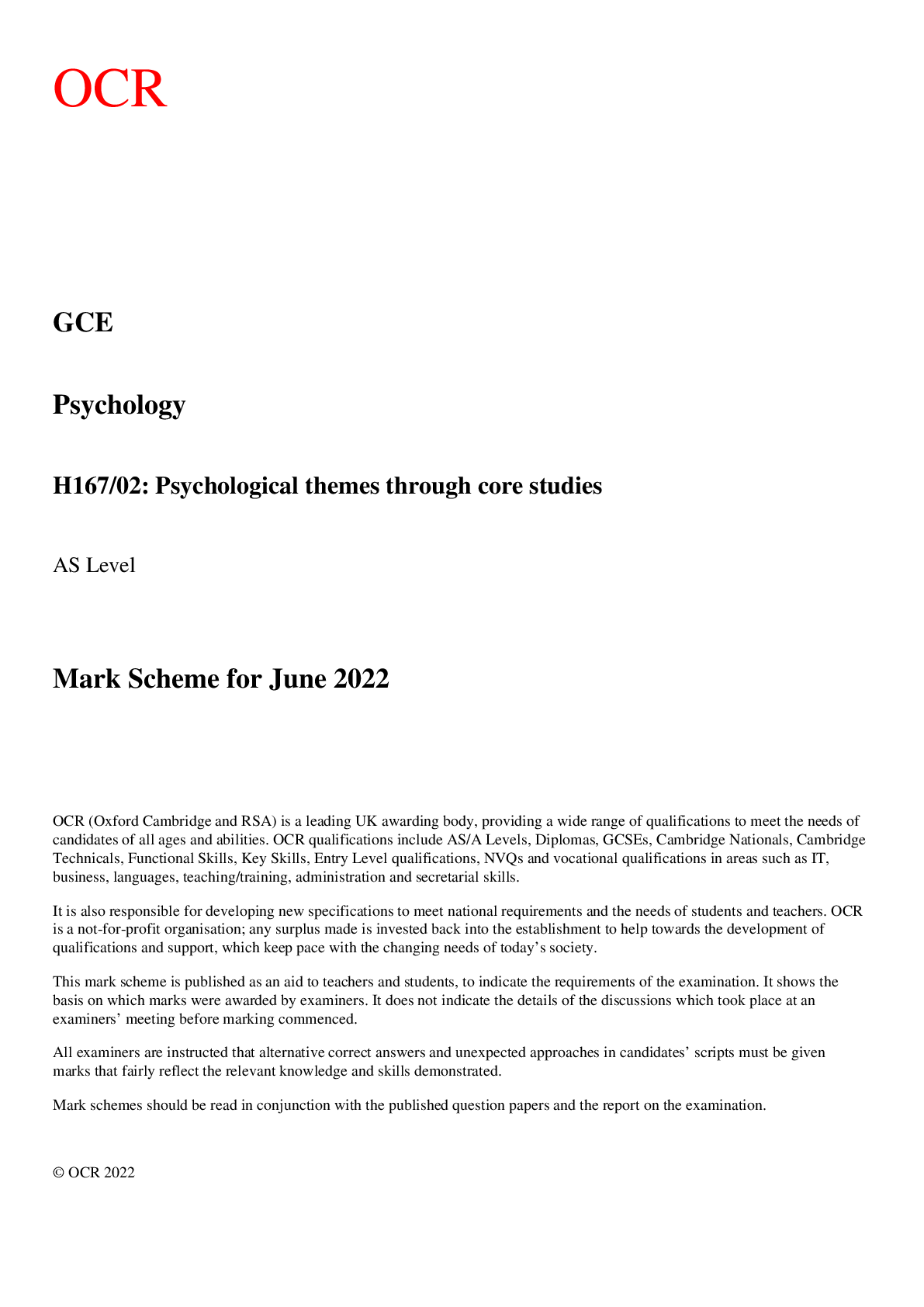
Buy this document to get the full access instantly
Instant Download Access after purchase
Buy NowInstant download
We Accept:

Reviews( 0 )
$17.00
Can't find what you want? Try our AI powered Search
Document information
Connected school, study & course
About the document
Uploaded On
May 18, 2023
Number of pages
20
Written in
Additional information
This document has been written for:
Uploaded
May 18, 2023
Downloads
0
Views
82

